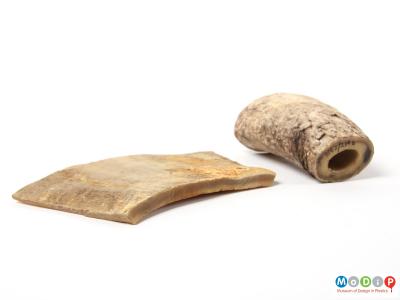To get from animal to finished artefact the horn has to go through a number of processes.
Separating the horn from the core (1): The first stage in working horn involves soaking the raw material in water to remove the bony core from the sheath of workable material.
As well as separating the core from the sheath, soaking and softening the horn has the added advantage of making it easier to cut or split.
Cutting (2): A knife is used to cut the horn either directly from tip to base or in a corkscrew fashion. The cut used depends on the shape of material required to work into the final object.
Splitting (3): Splitting is a skilled variation of cutting and results in thin leaves of material. Immersing in boiling water softens the material between each action, making it easier to separate the leaves.
Heating : Heat is applied to horn to make it malleable and easier to form into flat sections of shaped pieces. The temperature to which the material is heated is vital; if it is too cool it cannot be worked, if it is too hot the material will become brittle.
Pressing (4): To create flat pieces of horn the material is put under pressure between pre-heated plates held together in a press. The horn is allowed to cool within the press before it is removed.
Moulding (5): Many objects are heated a second time at a lower temperature to soften the material so that it can be moulded into a shape. This includes shoehorns, spoons, boxes and decorated back combs.
Staining (6): Horn takes dye very well for decorative effect. By changing the surface colour horn can be used to imitate more expensive materials such as tortoiseshell and ivory.
Carving (7) and engraving (8): Like wood, horn can be carved into a chosen shape, or a pattern can be engraved into the surface.
Finishing (9): One of the final stages of processing horn is to smooth the material by removing the outer bark and to polish the material to a high shine.








